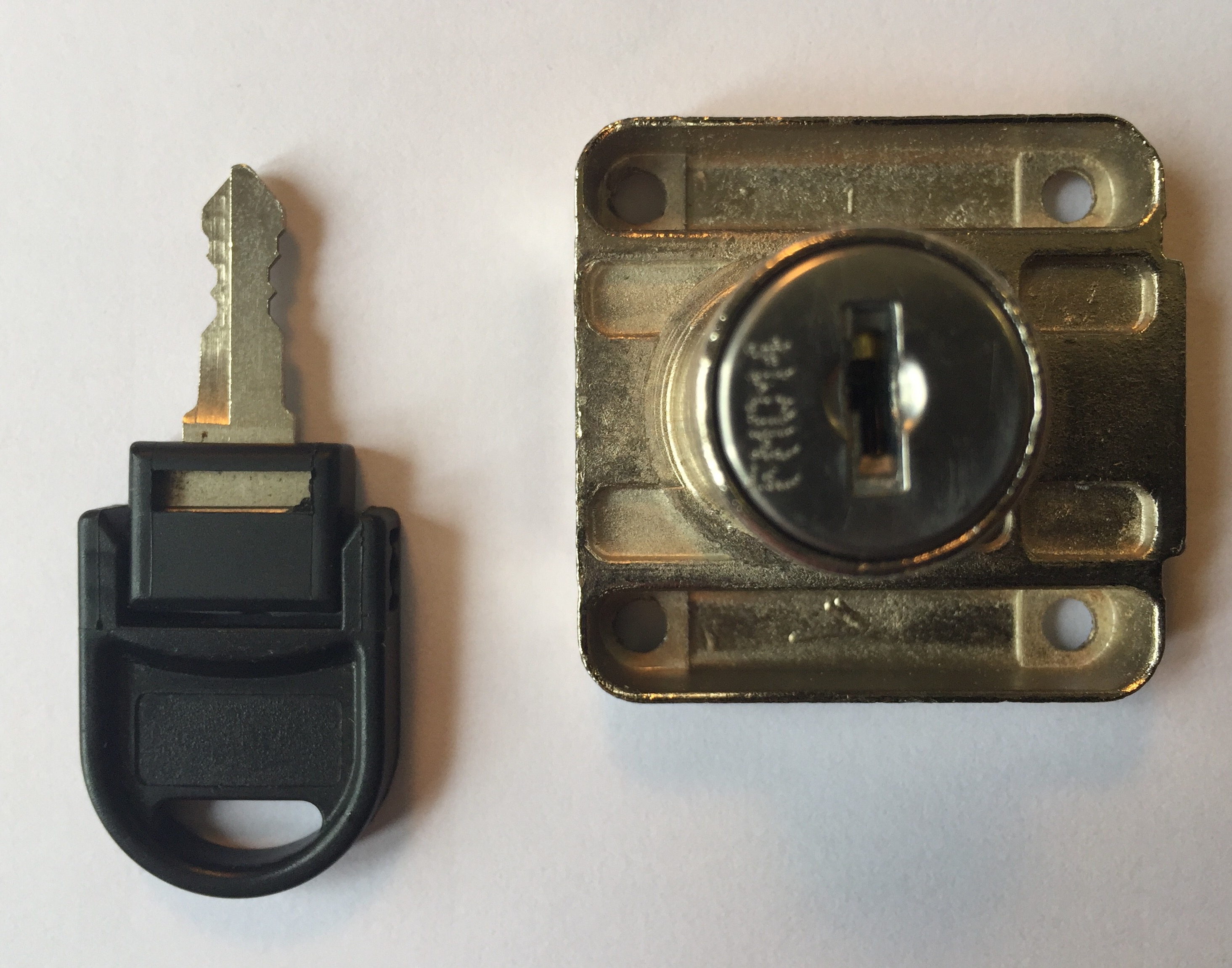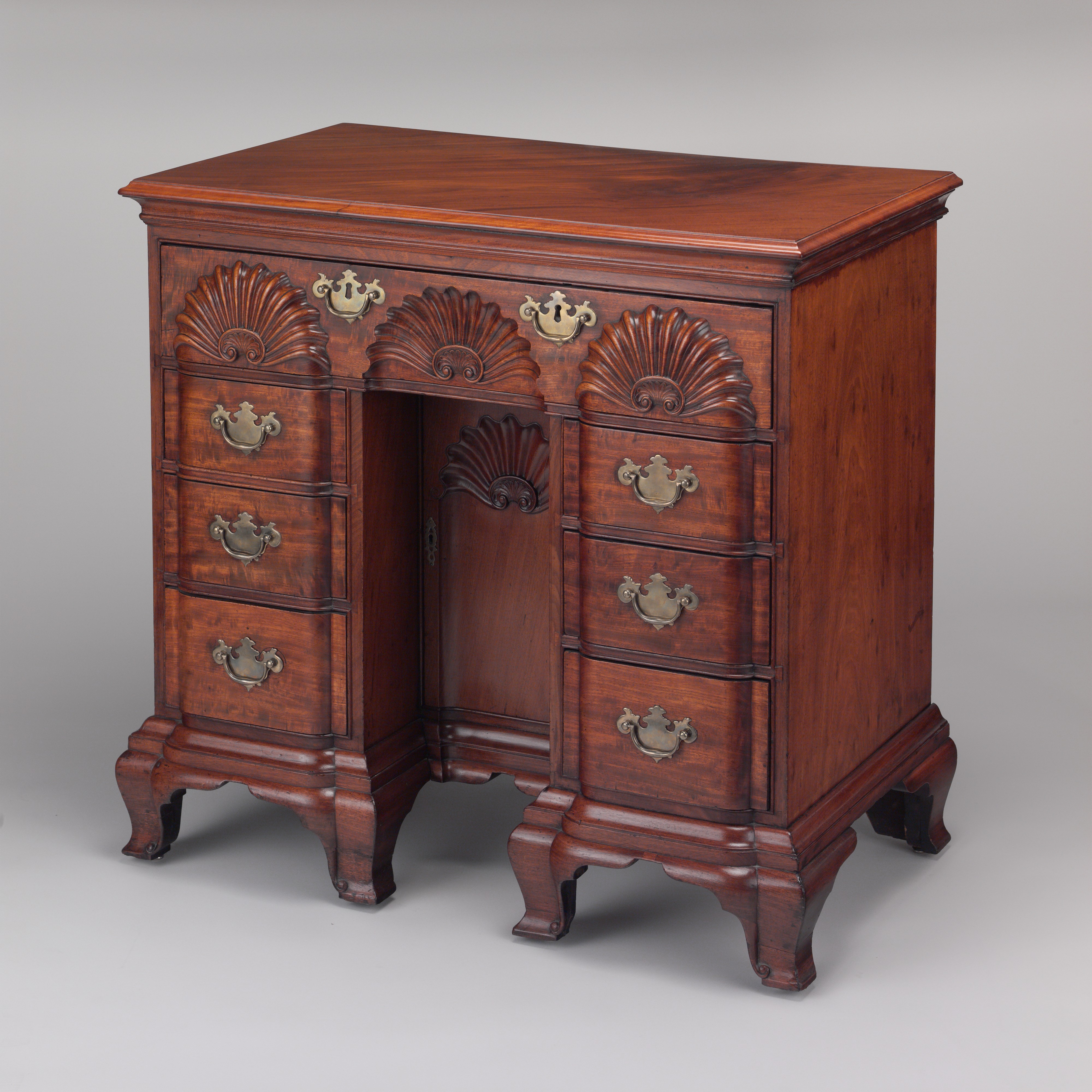|
Wafer Tumbler Lock
A wafer tumbler lock is a type of lock that uses a set of flat wafers to prevent the lock from opening unless the correct key is inserted. This type of lock is similar to the pin tumbler lock and works on a similar principle. However, unlike the pin tumbler lock, where each pin consists of two or more pieces, each wafer in the lock is a single piece. The wafer tumbler lock is often incorrectly referred to as a disc tumbler lock, which uses an entirely different mechanism. Early development The earliest record of the wafer tumbler lock in the United States is the patent in 1868 by Philo Felter. Manufactured in Cazenovia, New York, it used a flat double-bitted key. Felter's lock was patented only three years after Linus Yale, Jr. received a patent for his revolutionary pin tumbler mortise lock, considered to be the first pin tumbler lock of the modern era. That lock featured a flat steel key, referred to as a "feather key" because of the marked contrast with the heavy bit key ... [...More Info...] [...Related Items...] OR: [Wikipedia] [Google] [Baidu] |
Desk Wafer Tumbler Lock
A desk or bureau is a piece of furniture with a flat table-style work surface used in a school, office, home or the like for academic, professional or domestic activities such as reading, writing, or using equipment such as a computer. Desks often have one or more drawers, compartments, or pigeonholes to store items such as office supplies and papers. Desks are usually made of wood or metal, although materials such as glass are sometimes seen. Some desks have the form of a table, although usually only one side of a desk is suitable to sit at (there are some exceptions, such as a partners desk), unlike most usual tables. Some desks do not have the form of a table, for instance, an armoire desk is a desk built within a large wardrobe-like cabinet, and a portable desk is light enough to be placed on a person's lap. Since many people lean on a desk while using it, a desk must be sturdy. In most cases, people sit at a desk, either on a separate chair or a built-in chair (e.g., in ... [...More Info...] [...Related Items...] OR: [Wikipedia] [Google] [Baidu] |
Lock (security Device)
A lock is a mechanical or electronic fastening device that is released by a physical object (such as a key, keycard, fingerprint, RFID card, security token or coin), by supplying secret information (such as a number or letter permutation or password), by a combination thereof, or it may only be able to be opened from one side, such as a door chain. A key is a device that is used to operate a lock (to lock or unlock it). A typical key is a small piece of metal consisting of two parts: the ''bit'' or ''blade'', which slides into the keyway of the lock and distinguishes between different keys, and the ''bow'', which is left protruding so that torque can be applied by the user. In its simplest implementation, a key operates one lock or set of locks that are keyed alike, a lock/key system where each similarly keyed lock requires the same, unique key. The key serves as a security token for access to the locked area; locks are meant to only allow persons having the correct key to ope ... [...More Info...] [...Related Items...] OR: [Wikipedia] [Google] [Baidu] |
Pin Tumbler Lock
The pin tumbler lock is a lock mechanism that uses pins of varying lengths to prevent the lock from opening without the correct key. Pin tumblers are most commonly employed in cylinder locks, but may also be found in tubular pin tumbler locks (also known as radial locks or ace locks). History The first known example of a tumbler lock was found in the ruins of the Palace of Khorsabad built by king Sargon II (721–705 BC.) in Iraq.James, Peter, and I. J. Thorpe. Ancient Inventions. New York: Ballantine, 1994. Basic principles of the pin tumbler lock may date as far back as 2000 BC in Egypt; the lock consisted of a wooden post affixed to the door and a horizontal bolt that slid into the post. The bolt had vertical openings into which a set of pins fitted. These could be lifted, using a key, to a sufficient height to allow the bolt to move and unlock the door. This wooden lock was one of Egypt's major developments in domestic architecture during classical times. Such a ... [...More Info...] [...Related Items...] OR: [Wikipedia] [Google] [Baidu] |
Disc Tumbler Lock
A disc tumbler or disc detainer lock is a lock composed of slotted rotating detainer discs. The lock was invented by Finnish founder of Abloy, Emil Henriksson (1886–1959) in 1907 and first manufactured under the Abloy brand in 1918. Design Disc tumbler locks are composed of slotted rotating detainer discs. A specially cut key rotates these discs like the tumblers of a safe to align the slots, allowing the sidebar to drop into the slots, thus opening the lock. Unlike a wafer tumbler lock or a pin tumbler lock, this mechanism does not use springs. Because they do not contain springs, they are better suited for areas with harsh conditions and are often used at outdoor locations like railroad and public utility installations. The original Abloy Classic design consists of a notched semi-cylindrical key, and a lock with detainer discs with holes ranging from a semicircle (180°) to a 3/4 circle (270°). The key is inserted and rotated 90°. Notches, machined to an angle, correspo ... [...More Info...] [...Related Items...] OR: [Wikipedia] [Google] [Baidu] |
Linus Yale, Jr
Linus, a male given name, is the Latin form of the Greek name ''Linos''. It's a common given name in Sweden. The origin of the name is unknown although the name appears in antiquity both as a musician who taught Apollo and as a son of Apollo who died in infancy. People * Linus (Argive), son of Apollo and Psamathe in Greek mythology * Linus of Hollywood (Linus Dotson, born 1973), American musical artist *Linus of Thrace, musician and master of eloquent speech in Greek mythology *Pope Linus (died c. 76), the second Bishop of Rome and Pope of the Catholic Church * Linus Arnesson (born 1994), Swedish ice hockey player * Linus Bylund (born 1978), Swedish politician *Linus B. Comins (1817–1892), member of the U.S. House of Representatives from Massachusetts in 1857–59 * Linus Diaz (born 1933), Sri Lankan long-distance runner *Linus Eklöf (born 1989), Swedish motorcycle speedway rider * Linus Eklöw (better known by his stage name Style of Eye) (born 1979), Swedish DJ, producer, and s ... [...More Info...] [...Related Items...] OR: [Wikipedia] [Google] [Baidu] |
Yale (company)
Yale is one of the world's oldest lock manufacturers, owned by its parent company, Assa Abloy. Over its extensive history, Yale has received patents for dozens of its products, and the company has distributed its products to more than 120 countries, including Australia, Greece, India, Kuwait, and others. Yale's headquarters are located in Stockholm, Sweden. History In 1868, the business was founded in Stamford, Connecticut, by Henry R. Towne and Linus Yale Jr., an inventor of the pin tumbler lock. The founding name of the corporation was Yale Lock Manufacturing Co. and later the name was changed to Yale & Towne, basing themselves in Newport, New York.. From 1843 to 1857, Yale had registered eight patents, such as pin tumbler safe lock, safe lock, bank lock, vault, safe door bolt and padlock with the U.S. Patent and Trademark Office. Around 1876, they have added the manufacturing of chain blocks, electric hoists, cranes and testing machines, becoming the pioneer of crane b ... [...More Info...] [...Related Items...] OR: [Wikipedia] [Google] [Baidu] |
Briggs & Stratton
Briggs & Stratton Corporation is an American manufacturer of gasoline engines with headquarters in Wauwatosa, Wisconsin. Engine production averages 10 million units per year as of April 2015. The company reports that it has 13 large facilities in the U.S. and 8 more in Australia, Brazil, Canada, China, Mexico, and the Netherlands. The company's products are sold in over 100 countries across the globe. History In 1908, inventor Stephen Foster Briggs and investor Harold M. Stratton started an informal partnership to capitalize on the growing automobile industry. Eventually Briggs and Stratton settled on manufacturing automotive components and small gasoline engines. In 1919 Briggs & Stratton purchased the manufacturing rights for a small, simple two-seat vehicle with a gasoline engine called the Smith Flyer from the A.O. Smith Company in Milwaukee. The Flyer had a small gasoline engine mounted on a fifth wheel, or motor wheel. Briggs & Stratton made engine improvements tha ... [...More Info...] [...Related Items...] OR: [Wikipedia] [Google] [Baidu] |
Hupmobile
Hupmobile was an automobile built from 1909 through 1939 by the Hupp Motor Car Company of Detroit. The prototype was developed in 1908. History Founding In 1909, Bobby Hupp co-founded Hupp Motor Car Company, with Charles Hastings, formerly of Oldsmobile, who put up the first US$8,500 toward manufacturing Hupp's car. They were joined by investors J. Walter Drake, Joseph Drake, John Baker, and Edwin Denby. Drake was elected president; Hupp was vice president and general manager. Emil Nelson, formerly of Oldsmobile and Packard, joined the company as chief engineer. Hastings was named assistant general manager. In late 1909 Bobby's brother, Louis Gorham Hupp left his job with the Michigan Central Railroad in Grand Rapids and joined the company. Model 20 Hupp Motors obtained $25,000 (equal to $ today) in cash deposits at the 1909 automobile show (the lowest capitalization of Detroit's eight major car makers) to begin manufacturing the Hupp 20. The first cars were built ... [...More Info...] [...Related Items...] OR: [Wikipedia] [Google] [Baidu] |
Cylinder Lock
The pin tumbler lock is a lock mechanism that uses pins of varying lengths to prevent the lock from opening without the correct key. Pin tumblers are most commonly employed in cylinder locks, but may also be found in tubular pin tumbler locks (also known as radial locks or ace locks). History The first known example of a tumbler lock was found in the ruins of the Palace of Khorsabad built by king Sargon II (721–705 BC.) in Iraq.James, Peter, and I. J. Thorpe. Ancient Inventions. New York: Ballantine, 1994. Basic principles of the pin tumbler lock may date as far back as 2000 BC in Egypt; the lock consisted of a wooden post affixed to the door and a horizontal bolt that slid into the post. The bolt had vertical openings into which a set of pins fitted. These could be lifted, using a key, to a sufficient height to allow the bolt to move and unlock the door. This wooden lock was one of Egypt's major developments in domestic architecture during classical times. Suc ... [...More Info...] [...Related Items...] OR: [Wikipedia] [Google] [Baidu] |
Wafer Lock Try-Out Keys
A wafer is a crisp, often sweet, very thin, flat, light and dry biscuit, often used to decorate ice cream, and also used as a garnish on some sweet dishes. Wafers can also be made into cookies with cream flavoring sandwiched between them. They frequently have a waffle surface pattern but may also be patterned with insignia of the food's manufacturer or may be patternless. Some chocolate bars, such as Kit Kat and Coffee Crisp, are wafers with chocolate in and around them. Communion wafers A communion wafer is a type of unleavened bread consumed after transubstantiation as part of the Christian ritual of communion. Spa wafer Special "spa wafers" (Czech: ''lázeňské oplatky'', Slovak: ''kúpeľné oblátky'') are produced in the spa towns of the Czech Republic and the Slovak Republic (e.g. Piešťany). The production of the wafers in Karlsbad and Marienbad was traditional to the towns' German-speaking population, who, after the ethnic cleansing of the area, brought the cra ... [...More Info...] [...Related Items...] OR: [Wikipedia] [Google] [Baidu] |
Locks (security Device)
Lock(s) may refer to: Common meanings *Lock and key, a mechanical device used to secure items of importance *Lock (water navigation), a device for boats to transit between different levels of water, as in a canal Arts and entertainment * ''Lock'' (film), a 2016 Punjabi film * Lock (''Saga of the Skolian Empire''), a sentient machine in the novels by Catherine Asaro * Lock (waltz), a dance figure * ''Locked'' (miniseries), Indian web miniseries * ''The Lock'' (Constable), an 1824 painting by John Constable * ''The Lock'' (Fragonard) or ''The Bolt'', a 1777 painting by Jean-Honoré Fragonard * ''Locks'' (album), by Garnet Crow, 2008 People *Lock (surname) *Ormer Locklear (1891–1920), American stunt pilot and film actor nicknamed "Lock" * George Locks (1889–1965), English cricketer *Lock Martin (1916–1959), stage name of American actor Joseph Lockard Martin, Jr. Places *Lock, Ohio, an unincorporated community in the United States *Lock, South Australia, a small town in the c ... [...More Info...] [...Related Items...] OR: [Wikipedia] [Google] [Baidu] |


.jpg)
.jpg)

